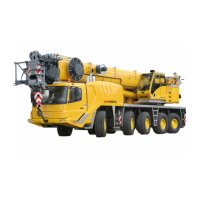INTRODUCTION RT9150E OPERATOR MANUAL
1-12
Published 2-23-2017, Control # 644-00
Method 2
Wind a length of soft annealed wire (Figure 1-6) around the
wire rope at least seven times. The two ends should be
twisted together in the center of the seizing. Tighten the
seizing by alternately prying and twisting. Cut off both ends
of the wire and pound the twist flat against the rope.
NOTE: Non-preformed wire rope (1) (Figure 1-7) should
have three seizings (3) located on each side of the
cut (4) as compared to preformed wire rope (2).
Installing 35x7 Class Wire Rope
1. Unload properly and relieve any twists. Pull the rope off
the shipping reel or unroll it from a shipping coil. (If done
improperly, you may kink the rope, which will result in
permanent damage to the rope.) Then, lay the rope on
the ground in direct line with the boom. This helps
release any twist in the rope.
2. Pull the rope over the point sheave and attach the end to
the hoist drum. Be sure not to remove the welded end.
3. Wind rope onto drum slowly and carefully. At this point, it
isn’t necessary to provide additional load other than the
weight of the rope being pulled across the ground.
4. Spool first layer tightly. It is essential on smooth-faced
drums that the first layer is spooled with wraps tight and
close together since the first layer forms the foundation
for succeeding layers. If need be, use a rubber, lead or
brass mallet (but never a steel hammer) to tap the rope
into place.
5. Spool multiple layers with sufficient tension. It’s very
important to apply a tensioning load to the ropes during
the rope breaking-in process. (If not, the lower layers
may be loose enough that the upper layers become
wedged into the lower layers under load, which can
seriously damage the rope.) The tensioning load should
range from 1 to 2% of the rope’s minimum breaking
force.
6. For ropes in multi-part systems: Reeve the traveling
block and boom tip sheaves so the rope spacing is
maximized and the traveling (hook) block hangs straight
and level to help assure block stability.
7. Breaking in new 35x7 class rope—After installation,
properly break in the rope, which allows the rope’s
component parts to adjust themselves to the operating
conditions:
With the boom fully raised and fully extended, attach a
light load at the hook and raise it a few inches off the
ground. Allow to stand for several minutes. Then cycle
the load between the full “up” and “down” positions
several times. Observe the drum winding and rope travel
for any potential problems.
After making the lifts with a light load, increase the load
and cycle it up and down a few times. This procedure will
CAUTION
Any cutting of this specific wire rope is not recommended.
If 35x7class wire rope must be cut for any reason, it is
necessary to follow the following instructions. Also, unlike
other types of wire rope, the ends on this wire rope must
be welded to retain the rotation resistant characteristics.
Reference Only

